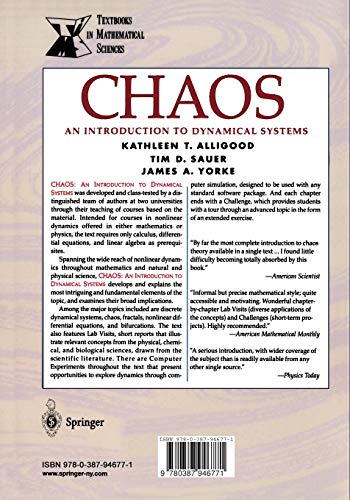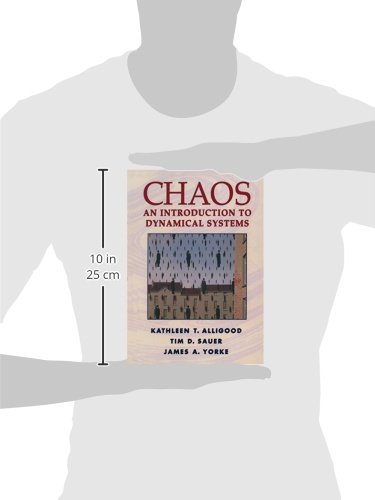



Chaos: An Introduction to Dynamical Systems (Textbooks in Mathematical Sciences)
E**I
It certainly isn't the best textbook I've used (as a math major) but it ...
I needed the book for class. It certainly isn't the best textbook I've used (as a math major) but it gets the job done. It could probably use better examples and more clear directives to illustrate points more clearly.
M**I
A/S/Y strike a perfect balance between theory and applications!
It was about the mid 1990's, still assimilating the big hype caused by the eventual and much-publicized proof by Andrew Wiles of Fermat's Last Theorem, when my curiosity (bolstered more by having seen a movie such as The Jurassic Park!) finally led me to taking a first college course on Chaos and Fractals at a California State school. At that time, the funny, surcastic, and somewhat sloppy foreign professor (who happened to be a country-mate of mine, for better or worse), had chosen the brand-new text "Fractals Everywhere" by Michael F. Barnsely for teaching our mid-size class consisting mainly of senior and first-year graduate students in math and sciences. I recall the discussion starting out by covering the basics about the metric spaces and sequences, and I having a head-start over many others coming fresh on the heels of a heavy-duty general topology course just in the previous semester (so for example I could show off to others on the first instruction day what it meant for two metrics to be equivalent). Still, I admit the semester went by without many of us really absorbing the nuts and bolts of the subject, for example why exactly topological transitivity was needed for chaos in an Iterated Function System, and why exactly some known fractals had the given fractional dimensions (eventhough we could compute them). However the students were generally happy to have scratched the surface of this vast, engaging subject, and for the time being it seemed about enough exposure for most of us. Consequently for me, during the several ensuing years in the late 90's the subject leapt mostly into the background, but nearly a decade later since I first took the college course, somehow it came back to the foreground in the company of several other applied subjects such as control, game theory, and information/coding theory.Now looking back, I find Barnsley's text a very good choice having gone through at the time, but the title by Alligood, Sauer, and Yorke (as a recommendation by a college professor at a different school who had taught his students from it) seemed like a more well-balanced introduction to the area of dynamical systems. In fact I also recall at the time there was a discussion as to whether yet another text by Robert Devaney would have made for a better first course. The aforementioned professor duely noted that Devaney only dealt with the discrete dynamical systems, while A/S/Y treated both the discrete and continuous, hence making the choice of the latter a more suitable one. In any event, the rundown of the topics discussed in the 13 chapters of A/S/Y include: one and two dimensional maps, fixed points, iterations, sinks, sources, saddles, Lyapunov exponents, chaotic orbits, conjugacy, fractals and their dimension, chaotic attractors, measure, Lotka-Volterra models, Poincare-Bendixson theorem, Lorentz and Roessler attractors, stable manifolds and crises, homoclinic and heteroclinic points, bifurcations, and cascades. There are answers and solutions to the selected exercises, as well as extensive references at the back, making up an ideal setting for self-study. The level and style of exposition is targeted towards an advanced undergraduate student who is into applied math or engineering fields. Therefore the authors emphasize concepts and applications instead of getting bogged down in too much mathematical rigor or heavy use of the abstract machinery (which is of course needed for a thorough treatment of the subject at an advanced level; there are in fact several newer titles which all occupy this niche). Notationally and stylistically also, A/S/Y is very accessible and attractive. All in all, an excellent first excursion/introduction to one of the most fascinating areas of applied math, whether for classroom use, or for self-study.
H**.
Dirty, but otherwise "very good"
The product came very dirty, but was otherwise in "very good" condition.
D**L
good for difference equation behavior
I think this book is really strong on discrete index dynamical systems (Chapters 1-4) but could use a rewrite on the continuous index portion (Chapter 7,8). I haven't read the later portion. Summary: Read this for difference equations, Strogatz for differential equations.
T**R
Four Stars
Very nice introduction to an increasingly important subject.
M**R
One Star
way over my head
K**U
Manifolds
This introduce the dynamical systems together with chaos from map and ordinary differentials equations clearly! It also talks about manifold! I likes it !
M**K
Great Book
This book is both simple enough to understand, and sophisticated enough to provide further understanding. If you are an second or third year undergraduate planning on graduate work, this book is a great way to catch up on advanced mathematics.
P**D
Standardtext zur Einführung in die Nichtlineare Dynamik
Ich habe mit diesem Werk die Grundlagen der Nichtlinearen Dynamik (im Volksmund auch Chaostheorie genannt) erlernt. Zu dem Zeitpunkt als ich das Buch las war ich bereits mit meiner Grundlagenausbildung in Theoretischer Physik fertig und spezialisierte mich in diesem Gebiet. Die im Lehrbuch verwendete Mathematik bereitete mir keine Probleme und ich konnte den Gedankengängen der Autoren sehr gut folgen. Jeder der sich so intensiv mit Mathematik oder Physik auseinandergesetzt hat, dass er über die Grundlagen dieser Gebiete hinaus gelangt ist, sollte ebenso keine Probleme haben, den Ausführungen der Autoren zu folgen. Ein grobes Verständnis der Theorie von Differentialgleichungen ist völlig ausreichend. Die Illustrationen sind stets sehr zielführend und die Ausführungen der Autoren sind ebenfalls klar und verständlich. Der Text bewegt sich auf allerhöchstem Niveau und ist in diesem Themenbereich einer meiner liebsten.Einziger Kritikpunkt ist die schlechte Qualität des Drucks (ich besitze die Springer International Edition). So deutlich wie der Ausdruck der Autoren ist die Schrift leider selten ;).Ich empfehle das Buch jedem, der sich in die Nichtlineare Dynamik einarbeiten möchte und die entsprechenden mathematischen Grundlagen mitbringt.
Trustpilot
2 days ago
4 days ago